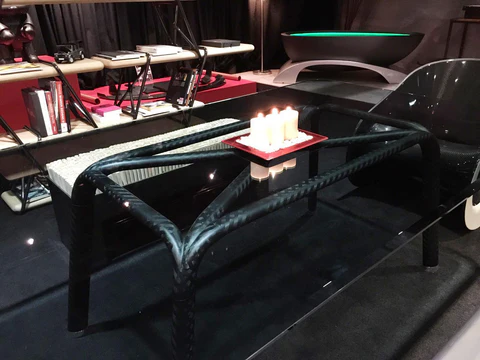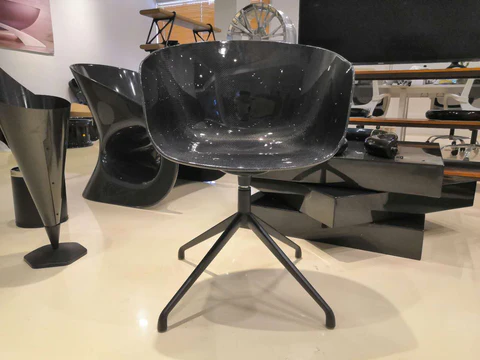Is Carbon Fibre Not Just for Cars Anymore? A Look at Its Rise in Furniture Design
- BY MUFARO MHARIWA

- Nov 29, 2024
- 4 min read

Photo: Mavimatt
In the luxury furniture market, it’s often materials with unique properties that define the latest trends. Carbon fibre, originally reserved for high-stakes applications like aerospace engineering and high-performance cars, is finding its way into the interiors of contemporary homes. Known for its light weight, exceptional strength, and cutting-edge appearance, carbon fibre is fast becoming a favourite among luxury design enthusiasts. Yet, as with any trend, there’s more than one side to consider—Is carbon fibre furniture truly as revolutionary as it seems, or is it simply the latest high-tech indulgence?
History of Carbon Fibre
Advertisement
Carbon fibre has a legacy steeped in advanced engineering, making its debut in the 1950s. Initially developed for applications where durability and weight mattered most, it became a favourite in fields like aerospace, sporting goods, and elite car manufacturing. However, by the 1990s, visionary designers began experimenting with carbon fibre in furniture, intrigued by its impressive strength-to-weight ratio. In interior spaces, it allowed for sleek, minimalist designs that were previously impossible with conventional materials.
The transition from high-performance industry staple to home décor showpiece wasn’t just about practicality; carbon fibre brought an aesthetic like no other. With its glossy black finish and distinctively modern sheen, it quickly found a place among collectors, luxury homeowners, and design aficionados.
The Allure of Carbon Fibre Furniture
Carbon fibre furniture isn’t merely functional; it’s a statement in style and engineering. But what’s driving its appeal in luxury interiors?
Exceptional Strength and Durability: Known for its high tensile strength, carbon fibre outperforms even steel at a fraction of the weight. This allows for thinner, sleeker furniture designs that are deceptively strong.
Lightweight Flexibility: The material’s strength-to-weight ratio enables bold, minimalist designs that are easy to move and incorporate into a variety of interiors, from ultra-modern to industrial chic.
Striking Aesthetic Appeal: With its smooth, glossy surface and distinctly high-tech look, carbon fibre furniture lends a futuristic elegance to any space, perfect for contemporary interiors that aim to feel ahead of the curve.
Eco-Friendly Potential: Carbon fibre is durable and long-lasting, which means pieces don’t need frequent replacement—a potential advantage for sustainability.
Advertisement
The Downsides of Carbon Fibre Furniture
As compelling as carbon fibre furniture may seem, it does come with several caveats. Understanding these factors is essential for anyone considering a piece as a long-term addition to their space.
Cost and Accessibility: Carbon fibre furniture remains a luxury product, with prices that often limit it to high-end buyers. The material itself is expensive to produce, and because of this, even small pieces can cost significantly more than traditional materials.
Environmental Impact: Despite its durability, carbon fibre production has a high carbon footprint due to the energy-intensive processes involved. Moreover, recycling carbon fibre remains a challenge, as the material isn’t easily broken down and repurposed. This places a question mark over its sustainability in the context of eco-consciozus design.

Vulnerability to Abrasion and Impact: While carbon fibre is exceptionally strong in tension, it can be surprisingly vulnerable to impacts and abrasions, especially along the edges. A sharp blow can result in splintering, and repairing it is not straightforward. This characteristic makes it less ideal for homes with young children or high-traffic areas where furniture might endure more wear and tear.
Limited Versatility in Design: Carbon fibre’s distinctive appearance can make it difficult to blend with other types of décor. While it shines in modern, minimalist spaces, it may clash with more traditional or rustic aesthetics, limiting its versatility.
A Niche Market with Growing Interest
Advertisement
Despite these drawbacks, carbon fibre furniture holds an undeniable allure in the high-end market. Brands like Lamborghini and Ferrari have even incorporated carbon fibre into select furniture collections, appealing to those who appreciate luxury both in their cars and their interiors. The material's exclusivity, combined with its status as a conversation piece, makes it an appealing choice for collectors and design enthusiasts seeking something unique.
However, as much as carbon fibre furniture attracts a particular crowd, it remains niche. The cost, combined with its potential environmental concerns, keeps it primarily within the realm of luxury, and the question of its longevity as a sustainable option is still under scrutiny.

With continued advancements, the cost of carbon fibre may one day lower, making it a more accessible option for mainstream furniture. Innovations are also underway to improve its sustainability, such as creating recycling methods that make it easier to repurpose. These efforts could help widen its appeal beyond high-end showrooms and bespoke design houses.
Carbon fibre’s journey from aerospace and automotive applications to our living rooms shows just how versatile this material can be. With a blend of stunning aesthetics, robust functionality, and undeniable exclusivity, carbon fibre furniture is making its mark in luxury interiors. However, the high costs, limited recyclability, and durability concerns mean it isn’t without drawbacks. For those who crave a high-tech, sophisticated statement piece, carbon fibre may be the ultimate addition—but it remains a commitment for the design-conscious who value innovation over tradition.






































































